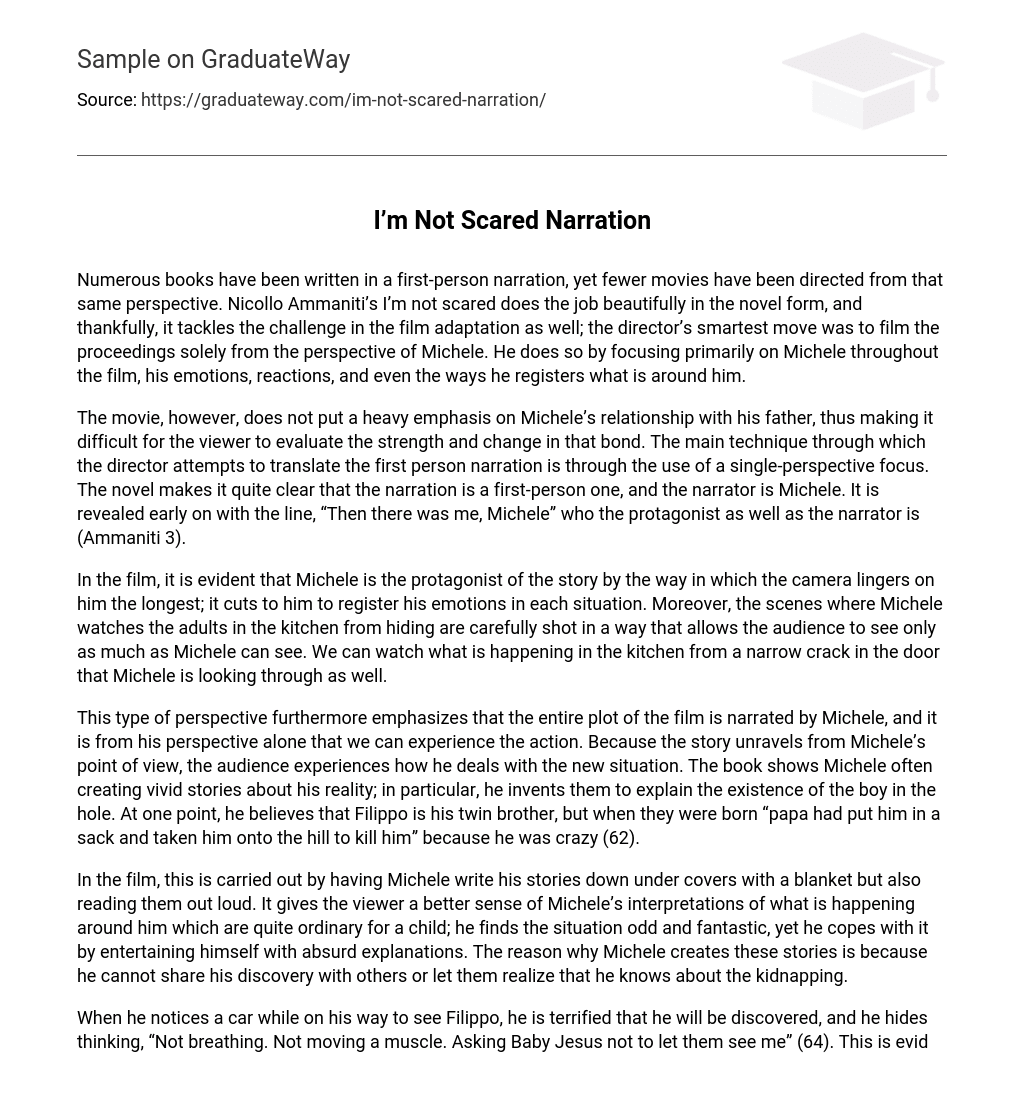Although there have been numerous books written in first-person narration, there have been fewer movies that adopt the same perspective. However, Niccolo Ammaniti’s novel “I’m not scared” successfully tackles this challenge and the film adaptation does so beautifully. The director’s clever decision to film the events solely from Michele’s perspective is the key factor. The film primarily focuses on Michele, capturing his emotions, reactions, and his observations of his surroundings.
The movie, however, does not give much importance to Michele’s relationship with his father, making it hard for the audience to understand the depth and development of that bond. The director’s main technique to convey the first-person narration is by focusing on a single perspective. In the novel, it is clearly stated that the narration is from Michele’s point of view. This is evident from the beginning when the narrator says, “Then there was me, Michele” (Ammaniti 3).
Throughout the film, Michele is clearly depicted as the protagonist. This is established by the frequent focus on him through extended shots, capturing his emotions in various situations. Additionally, the scenes where Michele secretly observes the adults in the kitchen are skillfully filmed, granting the audience the same limited perspective as Michele. Through a narrow crack in the door that he is peering through, we are able to witness the events unfolding in the kitchen.
This particular perspective emphasizes that the entire plot of the film is narrated by Michele alone, giving us the opportunity to perceive the action from his point of view. As the story unfolds through Michele’s eyes, we witness how he copes with the new situation. The book depicts Michele frequently crafting vibrant tales about his reality, specifically inventing them to explain the presence of the boy in the hole. At one point, he comes to believe that Filippo is his twin brother, but according to his account, “papa had put him in a sack and taken him onto the hill to kill him” due to his mental instability (62).
Within the film, Michele navigates his predicament by both recording and vocalizing his stories while hiding under covers with a blanket. Through this, the audience gains insight into Michele’s viewpoint on the events unfolding around him, which are rather ordinary for a child. He regards the situation as peculiar and extraordinary, but manages to cope by amusing himself with illogical explanations. The motive behind Michele crafting these tales lies in his inability to disclose his knowledge of the kidnapping or confide in others.
When Michele notices a car while on his way to see Filippo, he becomes terrified of being discovered, and he hides while praying for the Baby Jesus to help him remain unseen (64). This fear and isolation is depicted in the movie through the limited perspective of Michele. The audience is able to witness Michele’s overwhelming fear and confusion as he has no one to confide in or provide him with answers regarding the strange occurrences. Consequently, Michele’s viewpoint becomes the only one presented to us, further emphasizing his isolation and anxiety.
The portrayal of Michele’s relationship with his father differs in each medium, making it difficult to understand how Michele’s perspective of his father has evolved in the film. In the novel, it is evident that after his discovery, Michele’s perception of his father changes and he recognizes him as a threat. He even attempts to rescue his father from the monsters in the concluding scene. The end of the novel also highlights their relationship with the phrase, “And there was Papa.”
And there was me” (200). However, in the film, this bond is not as strong. The movie centers on Filippo and Michele’s special relationship. This is especially clear in the final scene. Unlike in the book, there is no mention of ‘dad and me’; Michele even acknowledges Filippo and vice versa when they try to hold hands. As a result, Michele’s internal struggle over the morality of his admired father, which was a prominent theme in the book, is not emphasized in the film.
From a distance, this novel may appear to be targeted at children due to its focus on kids as the main characters. However, although parents play secondary roles, it’s not the adult perspective that captivates us. “I’m Not Scared,” told from Michele’s viewpoint, showcases a child who initially lacks awareness of real danger but eventually becomes someone whose adult life is influenced by his experiences.
Work Cited
Ammaniti, Niccolo. I’m Not Scared. New York: Anchor, 2003. Print.





